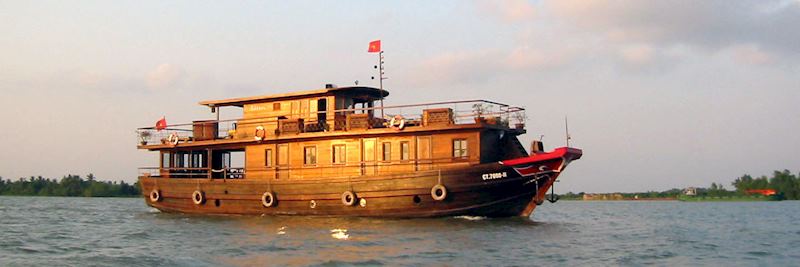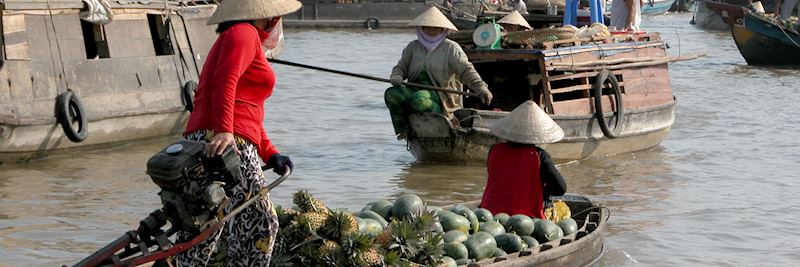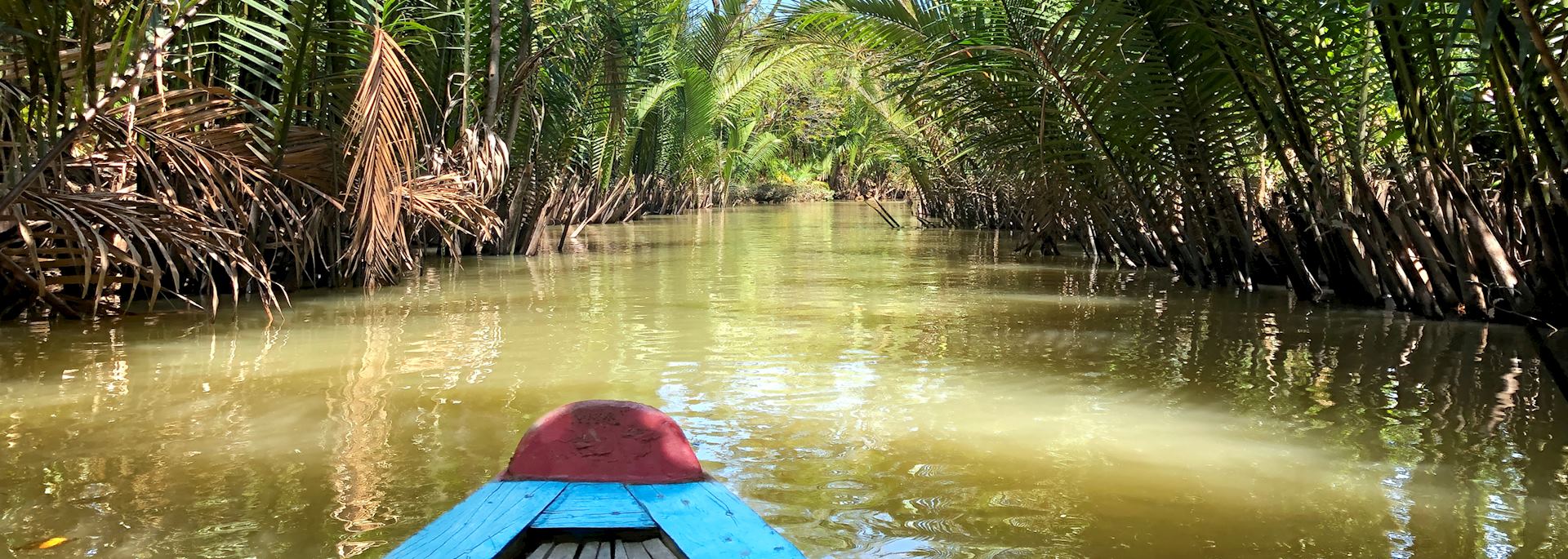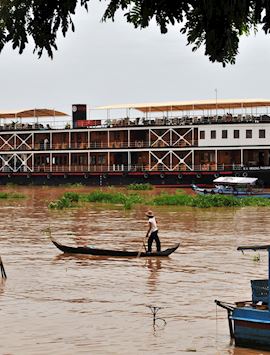By Southeast Asia specialist Thomas
As the Mekong River nears the end of its course from the Tibetan plateau to the South China Sea, it passes from Cambodia into Vietnam before splaying out into the Mekong Delta.
The river is a natural highway that's given rise to great cities, such as Cambodia's capital Phnom Penh, and by contrast the pastoral towns and villages that line its banks and draw life from its waters.
By travelling along the Mekong, you can easily manage Cambodia and Vietnam in a single trip, where you remove the need for internal flights, opting instead to experience the two countries’ landscapes and cultures guided by the ebb and flow of the river.
Why combine a tour of Cambodia and Vietnam?

The two nations complement each other incredibly well. Ho Chi Minh City, where the headlamps of a thousand Vespas light up the 19th-century French architecture and glistening skyscrapers, juxtaposes against traditional life along the Mekong Delta.
Then, by the time you reach Cambodia, the industry of the river is replaced by the uninterrupted vista of rice paddies receding into the distance.
The two cultures entwine at Cambodia's Tonle Sap lake. Here both Cambodians and Vietnamese — exiles of the war — live in the stilted villages that seemingly float on the lake's calm waters.
Both countries have experienced their own harrowing history. The depravity of the Khmer Rouge is still evident in and around Phnom Penh, while the Cu Chi Tunnels near Ho Chi Minh City are a poignant reminder of the Vietnam War.
I'd tactically plan to end your trip at the temples of Angkor, as nothing surpasses them for a parting impression.
My recommended itinerary for a holiday to Cambodia and Vietnam

I usually suggest only covering the south of Vietnam when you tie it together with Cambodia. Vietnam is a vast place and concentrating on one region will give you a better insight than trying to see too much and, as a result, only skimming the surface.
My advice would be to fly into Ho Chi Minh City and spend a few days enjoying the city (memorably for me, discovering Ho Chi Minh City after dark from the back of a Vespa), followed by a trip through the Mekong Delta by river boat, staying onboard a six-berth vessel for one or several nights.
Which boat to choose to cruise the Mekong

The Bassac boat is one of my suggested options: a converted rice barge combining tradition, comfort and some wonderful cuisine. For a more intimate experience, a private sampan lets you explore the region at your own pace.
Life along the Mekong Delta

It's just a two-hour drive from Ho Chi Minh City&˛Ô˛ú˛ő±č;łŮ´Ç Cai Be, where you can join the 4,000 km (2,485 mile)-long Mekong.
The scenery is a lush green tapestry of palm trees and paddy fields interspersed with rows of wooden floating villages and traditional fishing nets attached to the banks of the river.
From your riverboat you switch to a smaller boat able to navigate through the smaller channels of the Delta to stop off at weaving villages and farms.
The Delta is one of the most agriculturally productive areas in Southeast Asia, growing rice to feed Vietnam's expanding population as well as being a focus of fruit growing and fishing.
In coconut groves, farmers will sell you confectionary made from their crops, and you can drink tea with the owners of local fruit farms, where fruits like rambutan and mangosteen are grown.
The area is a major trade route between Vietnam and Cambodia, and the sounds of the floating river market of Cai Rang will rouse you from your sleep on your first full morning on board.
Cai Rang floating market

Traders travel from throughout the southern parts of Cambodia and Vietnam to buy from vessels laden with fresh fruit and vegetables.
One of my most enduring images of the region is the Mekong bustling with boats filled to the gunwales with brightly coloured dragon fruit and mangosteens. Vendors tout their wares on bamboo poles for potential customers to see.
You transfer to a smaller boat to join the throng and, if you wish, barter in what is the biggest example of a floating market along the Delta.
Crossing into Cambodia

The riverboat ends its journey in Can Tho, the Delta's biggest city. From here it's a three-hour drive to the border town of Chau Doc, passing through basket-weaving communities as you go.
It's easy to pick up a speedboat at Chau Doc to take you a further five hours upriver to Phnom Penh.
Here, you can learn more about Khmer Rouge history by visiting the Killing Fields and the Tuol Sleng Genocide Museum, the former S-21 prison where part of the mass genocide took place.
From Phnom Penh the route heads to Siem Reap, the gateway city to the temples of Angkor. This journey can be done by car following a six-hour route along the banks of Tonle Sap. Or, to save time, you might prefer a short one-hour flight.
Floating villages on Southeast Asia's largest freshwater lake

Tonle Sap Lake owes its very existence to the Mekong and it makes a fascinating day out of Siem Reap.
During the wet season, snow-melt in Tibet and the monsoon rains cause the Mekong water levels to rise rapidly, flowing northwest into the lake and increasing its size by up to five times.
It's an enormous body of water in the wet season, yet manages to drain almost completely into the Mekong in the dry season.
The way of life on the lake is deeply entwined with its natural cycles. Exploring by longtail boat enables you to connect with local communities who cope with the huge rise and drop in water levels by building stilted villages that appear to be floating on the lake's surface.
Angkor and my highlight temple, Ta Prohm

Scattered throughout a huge area of forest, the temples of Angkor are one of the world's greatest human-built wonders and people from far and wide come to this small corner of northwest Cambodia to marvel at their splendour.
Of all the temples, my personal favourite is Ta Prohm, recognisable by its crumbling buildings part strangled by the enormous roots of silk-cotton and fig trees.
Many of the guidebooks tell you to visit Angkor Wat — the largest temple — at dawn, but I'd steer you to Ta Prohm.
By visiting at sunrise with the benefit of a one-on-one guide, and a lack of other visitors, the experience becomes much more personal.
As the sun breaks, the temple is full of mystique as an eerily beautiful green light penetrates the tree canopy.
Visiting at dawn also gives you the day to explore Siem Reap or just relax by the pool as you near the end of your trip.
Spider whistling
Trip highlights, and the most genuine understanding of what daily life entails here, often come from unexpected meetings with local people and the unplanned detours you make.
About halfway along the drive from Phnom Penh to Siem Reap, I stopped with my guide at a little village where the inhabitants hunt spiders for food.
With my guide as interpreter, we were invited into a local family's home. I remember the fried tarantula laid out on the table, and the big bowl of crickets cooking on the fire. We were then taken on a short walk into the jungle to whistle for tarantulas, and see how they were caught.
Best time to visit Vietnam and Cambodia

Vietnam and Cambodia are subject to three different regional microclimates, so the months of March and April are when you'll find the best weather throughout the whole region.
I'd always recommend travelling in green season, from November to April. It presents better value in terms of accommodation and savings can be considerable. There will be certain places where you'll get a heavy downpour in the evening, but don't let that put you off.
Add some beach time in Thailand

If you want to end your trip on the beach, an option is to tag on a few days at the Thai beach resort of Koh Samet after flying from Siem Reap to Bangkok. It's just a couple of hours' drive from Bangkok, from where you can fly home. Departing from Bangkok is quite often a more cost-effective option, too.
Koh Samet is the best beach in the area without having to travel back into Vietnam, and you can catch a speedboat back to Bangkok airport.
Start planning your trip to Vietnam and Cambodia
Start thinking about your experience. These itineraries are simply suggestions for how you could enjoy some of the same experiences as our specialists. They're just for inspiration, because your trip will be created around your particular tastes.
View All Tours in Southeast Asia



